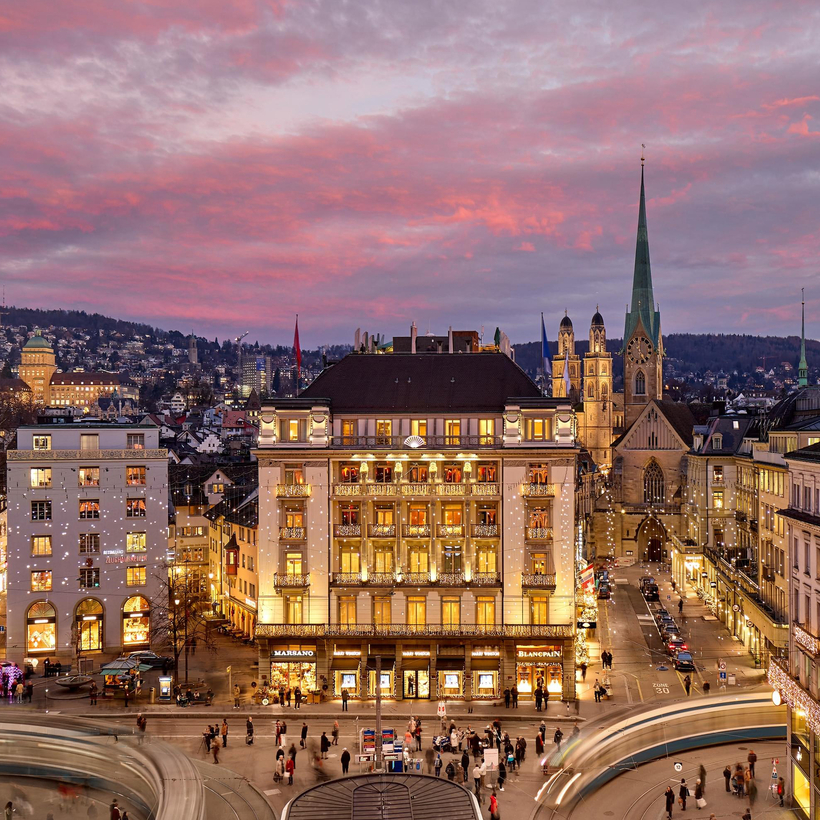“The Inns at Zürich are notoriously dirty, high priced and ill attended.” At least that’s what travel writer John Murray declared in his 1838 guidebook Murray’s Handbook for Travellers in Switzerland. Its publication launched the country as a tourist destination, and it also coincided with the opening of Hotel Baur, the first decent hotel in town. (In addition to 140 beds, it had stables for up to 40 horses.)

Founded by Johannes Baur, a shrewd baker from Austria, it fast became the place to stay, and some say that its popular roof terrace was the world’s first. Today, the stables are gone, but the hotel remains. Its rich and colorful history is woven through different chapters of its existence as the Baur, the Baur en Ville and, since 1908, the Savoy Baur en Ville.

Its views over the Alps have barely changed, and recently it reopened yet again, as the Mandarin Oriental Savoy. Many of its rooms overlook Paradeplatz, an imposing square in downtown Zurich. Once home to the city’s livestock market, it is now home to the headquarters of UBS and Credit Suisse, and it is one of the most expensive pieces of real estate in the country.

The Mandarin Oriental group has plenty of experience when it comes to restoring grandes dames; its recent renovation of the Ritz in Madrid was a triumph. For the Zurich project, they enlisted French interior designer Tristan Auer, whose work on the Carlton Cannes won much acclaim.
At the Mandarin Oriental Savoy, there are now just 44 spacious rooms and 36 suites. The original staircase winding up through the lobby and the travertine columns on the ground floor have been preserved and integrated into contemporary décor. Auer drew heavily on the colors of Zurich’s architecture, especially the verdigris from its many spires and the yellow of Chagall’s stained-glass windows in the neighboring Fraumünster Church.

Orsini, the hotel’s Italian restaurant (thought to be the oldest one in the city), is now under the steady hand of chef Antonio Guida. Seta, his outpost in the Mandarin Oriental’s Milan location, has earned two Michelin stars. Guida’s sensational raspberry risotto is well worth one’s time, but so is the satisfyingly crispy Wiener schnitzel at Savoy, the hotel’s more casual brasserie.

Three nights here is ideal. Then it’s time for gourmands to explore elsewhere, because some of Switzerland’s best food is happening in Fürstenau, which is considered the smallest city in the world.
It takes only two hours on the punctual Swiss trains to arrive at the 12th-century castle that’s now Schloss Schauenstein, which just celebrated its 20th anniversary as a small hotel and restaurant. Its charming rooms are rich with wood paneling and stucco work, and dramatic four-poster beds and freestanding tubs contribute to the fairy-tale feeling. When the Schloss opened, its proprietor, chef Andreas Caminada, was an ambitious 26-year-old; today, his restaurant group is operating locations in Switzerland and Thailand.

Caminda’s three-Michelin-starred food at Schloss Schauenstein may be Fürstenau’s main draw, but it is not its only pleasure. Opposite the Schloss, Caminada recently opened Oz, a vegetarian restaurant that serves garden-to-table dishes such as pumpkin-seed dough filled with marinated pumpkin and sage. Next door to that, Casa Caminada offers simple rooms and casual, locavore food. Its coffee is roasted on-site, and the smell of baked goods often permeates the air. Creak open the wooden door of the cellar to discover glass jars full of pickled purple beets and orange pumpkins. Here in Switzerland, these small pleasures seem to be everywhere.
Rooms at the Mandarin Oriental Savoy begin at $980 per night. Room rates at Schloss Schauenstein begin at $425.
Mary Lussiana is a Lisbon-based travel writer and reviewer of hotels


